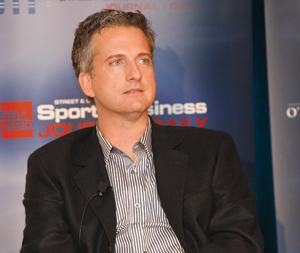The biggest sports media story last week had nothing to do with
Fox Sports 1 paying the new Big East hundreds of millions of dollars for its media rights, or
ESPN paying the old Big East nine figures for its rights.
The top story in my world last week dealt with ESPN’s plans to have one of its biggest stars, Bill Simmons, offer live commentary on the NCAA tournament via YouTube.
I’m serious. Consumers increasingly are using smartphones and tablets as a companion to watching television. For more than a year, networks have been trying to figure out how to program what they’ve been calling the “second screen.”
The Simmons approach is a bold effort, since some of the live commentary last week was slated to occur during game action. That’s what makes this test unique: ESPN doesn’t hold the TV rights to that game action but is looking to control a segment of the conversation.
If successful, the effects could be significant.
 |
ESPN’s Bill Simmons will use YouTube to comment on NCAA tournament games, which are being shown on other stations.
Photo: SHANA WITTENWYLER
|
What’s to stop
Turner’s
Ernie Johnson,
Kenny Smith and
Charles Barkley from putting on their own online halftime show around the NBA Finals, even though the games are on
ABC? Or how about
NBC firing up its 30 Rock studio to have
Dan Patrick,
Tony Dungy and
Rodney Harrison analyze ESPN’s “Monday Night Football” games online, starting with a couple of minutes left in the first half?
The move underscores how important television networks view the second screen. This was one of the dominant themes to come out of the South by Southwest conference in Austin, Texas, earlier this month.
“What’s different now is the second screen,” said Jason Kint, senior vice president and general manager of CBSSports.com. “You still have the big screen — nobody’s messing with the big screen — but now you have that second option.”
So far, networks generally have programmed the second screen for avid fans. With NFL games, they have played around with different camera angles. The Masters trains its online cameras on Amen Corner.
But networks are finding success by programming the second screen as a companion to television and trying to draw in more casual viewers. That’s what CBSSports.com did during the Super Bowl, Kint said during a panel discussion at the SXSW show. (Full disclosure: I also was on Kint’s SXSW panel.)
“Some of the stuff was natural. We knew that viewers wanted it, and we delivered,” Kint said. “Sometimes there were things that you’d never think of.”
Kint said he was surprised by the popularity of some camera angles, such as the “All-22” camera that showed all 22 players on the field at once, essentially shooting from the worst seat in the house. It was a CBS camera that typically had only been used for replays on TV.
“It was an angle from on high,” Kint said, “but you also had the big screen and the CBS folks with 60-plus cameras telling the story. Then, on your lap, you could see all the players on the field.”
The notion of trying to figure out how to control the second screen is not just limited to the TV networks. The NFL hosted its Digital Media Summit in Austin for the three days before SXSW, and reps from every NFL team descended on the city to find out the best ways to program and advertise on digital media. While those in attendance didn’t refer to digital programming as the second screen, they clearly are trying to figure out better ways to engage with fans.
“The popularity of digital sports has never been greater, and with the space offering such deep engagement, it’s an appealing place for innovation,” said George Scott, the NFL’s general manager of club sites.
Sports still is not a big part of SXSW — this year, at least, entertainment networks had a much bigger presence at the show — but as the importance of the second screen grows, I would expect more sports executives to make their way to Austin each March.
“I can definitely see sports having a growing presence at SXSW,” Scott said. “The event has become such a draw for influential people in the digital space.”
John Ourand can be reached at jourand@sportsbusinessjournal.com. Follow him on Twitter @Ourand_SBJ.





